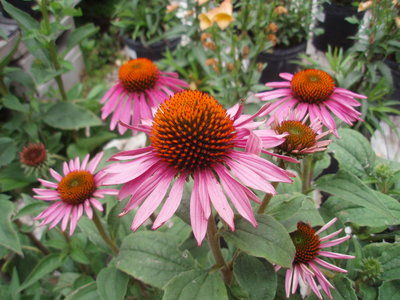
In case you haven’t been keeping track, summer is winding down. True, we will be enjoying great weather for months to come, but nature uses daylight hours to mark its calendar. And even though I’m busy visiting readers’ gardens, camping, hiking and painting, there are some tasks I need to do in my own garden.
Around this time of year, annual and perennials in containers and hanging baskets can become leggy, with flowers only at the end of long branches. At the same time, overly rambunctious growers can overwhelm neighboring plants, crowding or even suffocating them for lack of light and air.
Renew them by cutting back about half of the stems two-thirds of the way to the base. When those stems grow back and begin to bloom in about two weeks, cut back the remaining long stems the same way. While you’re at it, cut back aggressive growers as far as necessary to give surrounding plants space for healthy growth. Fertilize with a soluble plant food to keep them blooming through October.
Deadhead flowering annuals and perennials in the ground as often as you possibly can. Annuals like zinnias and cosmos will stop blooming if you allow them to go to seed. The same is true of repeat-blooming perennials, like dahlia, scabiosa, marguerites and lantana.
These plants know they’re on this Earth to reproduce. If they get a chance to set seed, the show is over; they’ve raised their family. Try to remove fading flowers regularly and you’ll be amply rewarded.
Fertilize shrubs lightly one last time in August or September, if you haven’t already done so this month. All shrubs, especially broad-leaved evergreens, such as rhododendron, pieris, camellia and hebe, need to calm down, stop growing and harden off to get ready for the winter cold. Some plants have already set next year’s buds.
Roses especially appreciate a bit of fertilizer now, which encourages them to bloom another round in September and October. To keep them blooming, make a habit of pinching and pruning off old flowers. Always cut back to an outward-facing branchlet with five leaves. There are hormones there that will cause a new rose to grow much sooner than if you cut to one with only three leaves.
Here are more to-do’s for late August for this area:
– Prune fruit trees that have already finished fruiting. Wait to prune others until after harvest, although many gardeners see summer pruning as a way to thin an overabundant crop. Summer pruning opens the tree to light, producing bigger, healthier fruit. Overall, summer pruning will slow the growth of a tree by removing energy-wasting water sprouts, helping keep dwarf trees a manageable size.
– Sow root veggies, such as beets, carrots, leeks, onions and parsnips, directly in the ground, and start germinating cool-season veggies — broccoli, cabbage, cauliflower, chard, lettuce and spinach — so they are ready to plant in mid-September.
– Now that you’ve taken care of your chores, reward yourself by adding perennials to your garden for color in late summer through fall. Good choices include aster, chrysanthemum, coreopsis, gaillardia, gaura, Japanese anemone, echinacea, rudbeckia, Russian sage, scabiosa, Mexican marigold, verbena and yarrow.
– Blooming shrubs that will flower well into fall are abutilon, blue hibiscus, butterfly bus, cape fuchsia, plumbago, lavatera, princess flower and salvia.
Jan Nelson, a landscape designer and California certified nursery professional at Plant Works in Ben Lomond, will answer questions about gardening in the Santa Cruz Mountains. E-mail her at ja******@*ol.com, or visit www.jannelsonlandscapedesign.com to view past columns and pictures.












